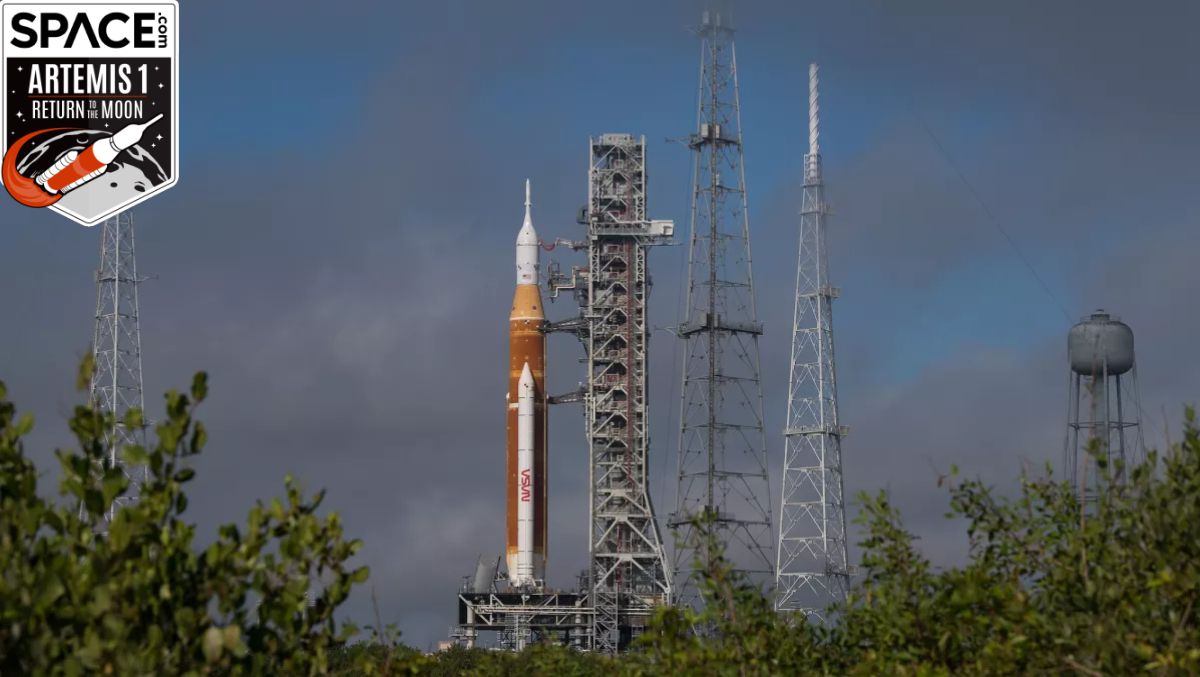
NASA's Artemis 1 moon rocket is staying at the launch pad, at least for now.
Artemis 1 will use NASA's new Space Launch System (SLS) megarocket to send an uncrewed Orion capsule to lunar orbit and back. NASA attempted to launch the epic mission on Saturday (Sept. 3) but stood down when it couldn't troubleshoot a leak of supercold liquid hydrogen (LH2) propellant in time for liftoff.
The leak occurred at a "quick disconnect," an interface connecting the SLS core stage with a propellant line coming from the giant rocket's mobile launch tower. After analyzing the issue for a few days, the Artemis 1 team has decided to replace the seal on the misbehaving quick disconnect, agency officials announced in an update on Tuesday evening (opens in new tab) (Sept. 6).
Related: NASA's Artemis 1 moon mission: Live updates
More: NASA's Artemis 1 moon mission explained in photos
This work will be done at Pad 39B at Kennedy Space Center (KSC) in Florida, where the Artemis 1 stack has been perched for the past three weeks.
"Performing the work at the pad requires technicians to set up an enclosure around the work area to protect the hardware from the weather and other environmental conditions but enables engineers to test the repair under cryogenic, or supercold, conditions," NASA officials wrote in the Tuesday update.
"Performing the work at the pad also allows teams to gather as much data as possible to understand the cause of the issue," they added. "Teams may return the rocket to the Vehicle Assembly Building (VAB) to perform additional work that does not require use of the cryogenic facilities available only at the pad."
And a rollback to the VAB may be required whether or not the team wants to perform more repairs there. The U.S. Space Force has certified Artemis 1's flight termination system (FTS), which would destroy the rocket if it veered off course during liftoff, for just a 25-day stretch. (The Space Force oversees the Eastern Range, the huge rocket-launch region that includes KSC.) That deadline will have passed by Sept. 19, when the next Artemis 1 launch window opens.
Recertification requires testing the FTS, which can only occur in the VAB. NASA officials have said they might apply for another waiver to extend the certification period, which would allow Artemis 1 to stay on the pad longer, but it's unclear at this point if they will do so. (Artemis 1 has already received one such waiver, from 20 days to 25.)
Related stories:
Saturday's scrub was the second for Artemis 1. The first, which occurred on Aug. 29, was spurred by a measurement indicating that one of the four engines on the SLS core stage wasn't cooling to the proper prelaunch temperature. The Artemis 1 team quickly concluded that the reading was caused by a faulty temperature sensor and decided to press ahead with a Saturday attempt.
The team also troubleshot an LH2 leak during the Aug. 29 attempt, but that one was much smaller than the leak the team is working on now.
Artemis 1 has two launch windows available in the next two months. The first runs from Sept. 19 to Oct. 4, and the second is open from Oct. 17 to Oct. 31. A rollback to the VAB would almost certainly put the Sept. 19-Oct. 4 window out of reach.
Mike Wall is the author of "Out There (opens in new tab)" (Grand Central Publishing, 2018; illustrated by Karl Tate), a book about the search for alien life. Follow him on Twitter @michaeldwall (opens in new tab). Follow us on Twitter @Spacedotcom (opens in new tab) or on Facebook (opens in new tab).
https://news.google.com/__i/rss/rd/articles/CBMiPWh0dHBzOi8vd3d3LnNwYWNlLmNvbS9uYXNhLXJlcGxhY2Utc2VhbC1hcnRlbWlzLTEtbW9vbi1yb2NrZXTSAQA?oc=5
2022-09-06 23:39:58Z
1557158975
Tidak ada komentar:
Posting Komentar